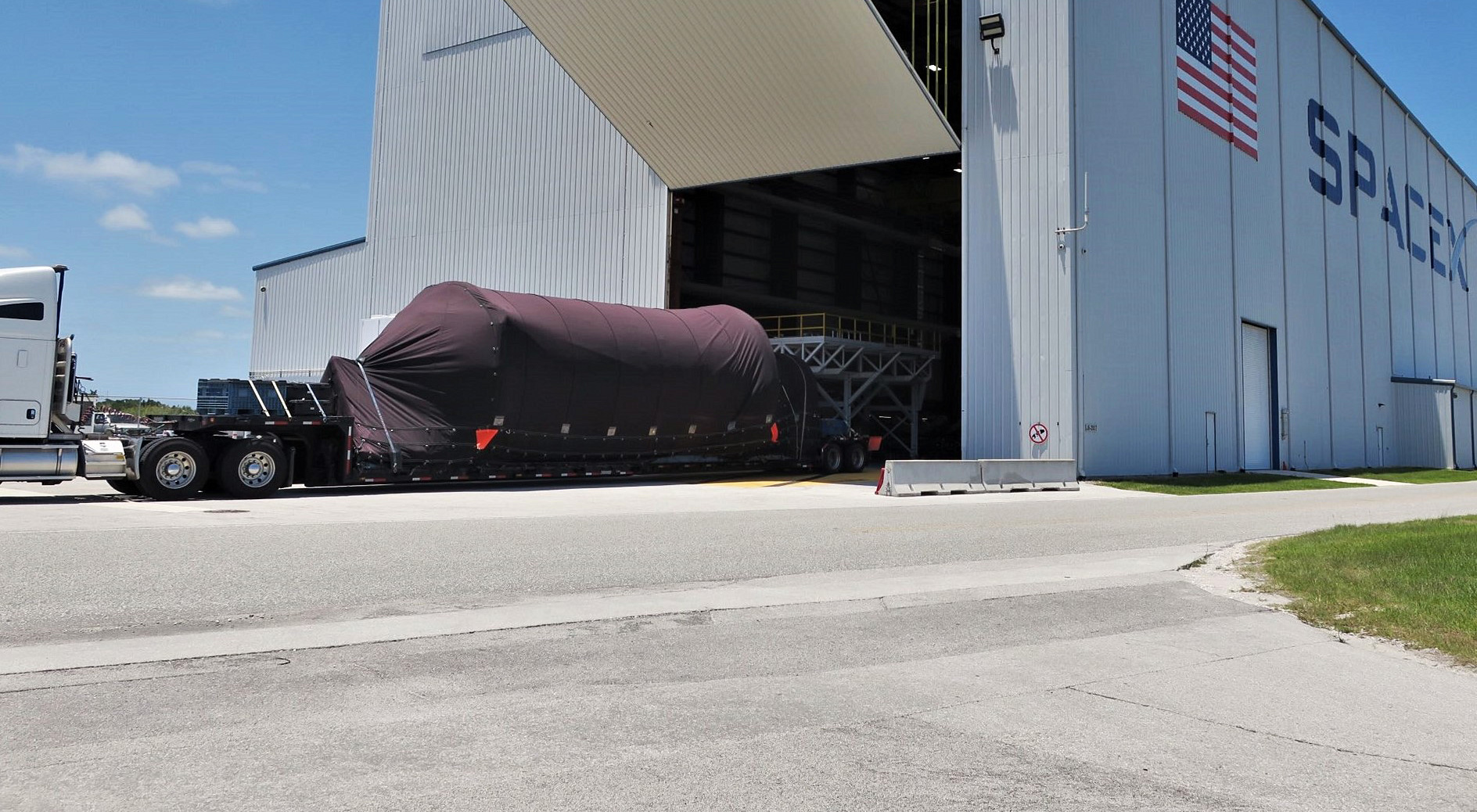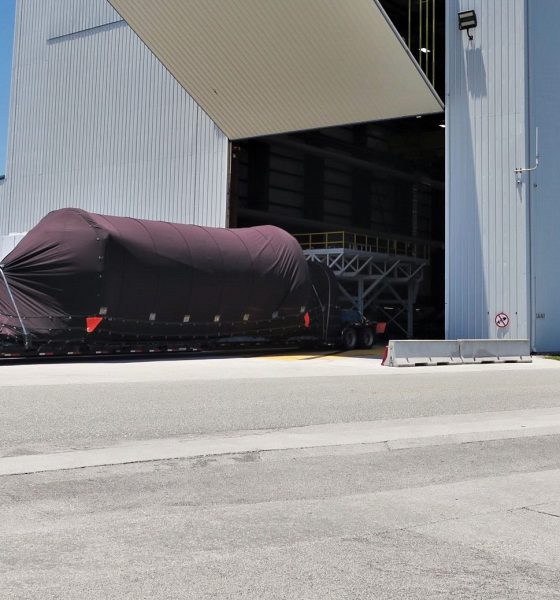

News
SpaceX’s next Falcon Heavy hits milestone as final rocket parts arrive in Florida
SpaceX has reached a critical milestone on the road to Falcon Heavy’s third flight: all major parts of the rocket – three boosters, an interstage, and a payload fairing – are now officially on-site at the company’s Pad 39A launch facilities.
This means that all that stands between SpaceX, the USAF, and the critical mission is the integration of the hardware into one vehicle, as well as the integration and encapsulation of all 24 customer satellites in the Falcon payload fairing. As noted by the USAF Space and Missile Systems Center (SMC), Falcon Heavy’s Space Test Program-2 (STP-2) mission will be exceptionally challenging and important for SpaceX for a variety of reasons.
Falcon Heavy: The Upper Stagening
Although the general performance of the three first stage boosters will be absolutely critical, the US Air Force’s STP-2 mission manages to cram in several additional major goals. First and foremost, all eyes will be on SpaceX’s Falcon upper stage (S2). Scheduled to last no less than several hours, the upper stage will be put through its paces like never before, requiring four separate ignitions and shutoffs of its Merlin Vacuum engine. For SpaceX, this may be the first time the company has ever attempted the feat – if any on-orbit testing has been done after completing customer missions, SpaceX has never commented on it.
Back in February 2018, Falcon Heavy’s launch debut also happened to mark the first flight-test of a true long-duration upper stage coast and third ignition, a spectacular success that sent Starman and a Tesla Roadster into a heliocentric orbit that now reaches beyond Mars. As such, SpaceX will by no means be walking into the challenges of STP-2 unprepared. In fact, the coast required on Flight 1 may have technically been more challenging than any one of the four separate burns S2 will need to perform on STP-2. However, combining the need to do all four burns and deployments rather quickly and in sequence, the critical need for accurate orbital insertions, and high standards of reliability and mission assurance expected by the USAF, STP-2 will easily be the hardest mission SpaceX has yet to attempt.

If SpaceX succeeds, the benefits will stretch far beyond simply satisfying an Air Force requirement and securing the USAF’s Falcon Heavy certification. Once SpaceX has rigorously demonstrated the reliability of Falcon 9’s upper stage for long coasts and high numbers of ignition events, the company will be able to apply that as a marketable product. Potential customers include the usual communications satellite operators desiring a direct-to-GEO insertion, saving time (and thus making money faster) by skipping the orbit-raising that comes with easier transfer orbits.
One major use-case – as demonstrated by Falcon Heavy’s interplanetary launch debut – is sending payloads beyond Earth orbit, a capability that NASA would undoubtedly take advantage of.
Reusability makes a surprise entrance
But wait, there’s more! In a predictable but still largely unexpected turn of events, the Air Force has also selected Falcon Heavy’s STP-2 mission as an opportunity to gain familiarity with the rocket reusability SpaceX is famous for. Falcon Heavy’s second mission and commercial launch debut – Arabsat 6A – used three all-new Block 5 boosters, two of which returned to land after gentle recoveries. Known as B1052 and B1053, the lightly-used boosters are now scheduled to become the first flight-proven orbital-class rockets launched on a Department of Defense (DoD) mission in 25 years, since the Space Shuttle’s final military mission in 1992.
If successful, SpaceX will help pave the way for the US military to seriously adopt reusable rockets and develop the “certification” procedures needed to do so. This will benefit all prospective US launch providers, not just SpaceX, but SpaceX will likely be the only company flying valuable payloads on flight-proven rockets until Blue Origin and ULA’s Vulcan achieve flight-proven certification for military launches. Much like regular certification often requires multiple launch demonstrations, flight-proven certification will likely be at least as – if not more – stringent. For New Glenn, that milestone might come as early as 2023-2025, while Vulcan – if a reusable engine section is ever actually implemented – is unlikely to even complete its launch debut – let alone first reuse – before 2025.
As such, SpaceX is quite literally half a decade ahead of its prospective competitors when it comes to certifying flight-proven rockets for high-value launches. Additionally, just the act of the USAF completing its development of a reusability certification process will likely encourage – if not directly lay the foundation for – NASA to seriously consider doing the same with its own launch services.
Check out Teslarati’s Marketplace! We offer Tesla accessories, including for the Tesla Cybertruck and Tesla Model 3.

News
Tesla (TSLA) receives “Buy” rating and $551 PT from Canaccord Genuity
He also maintained a “Buy” rating for TSLA stock over the company’s improving long-term outlook, which is driven by autonomy and robotics.

Canaccord Genuity analyst George Gianarikas raised his Tesla (NASDAQ:TSLA) price target from $482 to $551. He also maintained a “Buy” rating for TSLA stock over the company’s improving long-term outlook, which is driven by autonomy and robotics.
The analyst’s updated note
Gianarikas lowered his 4Q25 delivery estimates but pointed to several positive factors in the Tesla story. He noted that EV adoption in emerging markets is gaining pace, and progress in FSD and the Robotaxi rollout in 2026 represent major upside drivers. Further progress in the Optimus program next year could also add more momentum for the electric vehicle maker.
“Overall, yes, 4Q25 delivery expectations are being revised lower. However, the reset in the US EV market is laying the groundwork for a more durable and attractive long-term demand environment.
“At the same time, EV penetration in emerging markets is accelerating, reinforcing Tesla’s potential multi‑year growth runway beyond the US. Global progress in FSD and the anticipated rollout of a larger robotaxi fleet in 2026 are increasingly important components of the Tesla equity story and could provide sentiment tailwinds,” the analyst wrote.
Tesla’s busy 2026
The upcoming year would be a busy one for Tesla, considering the company’s plans and targets. The autonomous two-seat Cybercab has been confirmed to start production sometime in Q2 2026, as per Elon Musk during the 2025 Annual Shareholder Meeting.
Apart from this, Tesla is also expected to unveil the next-generation Roadster on April 1, 2026. Tesla is also expected to start high-volume production of the Tesla Semi in Nevada next year.
Apart from vehicle launches, Tesla has expressed its intentions to significantly ramp the rollout of FSD to several regions worldwide, such as Europe. Plans are also underway to launch more Robotaxi networks in several more key areas across the United States.
News
Waymo sues Santa Monica over order to halt overnight charging sessions
In its complaint, Waymo argued that its self-driving cars’ operations do not constitute a public nuisance, and compliance with the city’s order would cause the company irreparable harm.

Waymo has filed a lawsuit against the City of Santa Monica in Los Angeles County Superior Court, seeking to block an order that requires the company to cease overnight charging at two facilities.
In its complaint, Waymo argued that its self-driving cars’ operations do not constitute a public nuisance, and compliance with the city’s order would cause the company irreparable harm.
Nuisance claims
As noted in a report from the Los Angeles Times, Waymo’s two charging sites at Euclid Street and Broadway have operated for about a year, supporting the company’s growing fleet with round-the-clock activity. Unfortunately, this has also resulted in residents in the area reportedly being unable to sleep due to incessant beeping from self-driving taxis that are moving in and out of the charging stations around the clock.
Frustrated residents have protested against the Waymos by blocking the vehicles’ paths, placing cones, and “stacking” cars to create backups. This has also resulted in multiple calls to the police.
Last month, the city issued an order to Waymo and its charging partner, Voltera, to cease overnight operations at the charging locations, stating that the self-driving vehicles’ activities at night were a public nuisance. A December 15 meeting yielded no agreement on mitigations like software rerouting. Waymo proposed changes, but the city reportedly insisted that nothing would satisfy the irate residents.
“We are disappointed that the City has chosen an adversarial path over a collaborative one. The City’s position has been to insist that no actions taken or proposed by Waymo would satisfy the complaining neighbors and therefore must be deemed insufficient,” a Waymo spokesperson stated.
Waymo pushes back
In its legal complaint, Waymo stated that its “activities at the Broadway Facilities do not constitute a public nuisance.” The company also noted that it “faces imminent and irreparable harm to its operations, employees, and customers” from the city’s order. The suit also stated that the city was fully aware that the Voltera charging sites would be operating around the clock to support Waymo’s self-driving taxis.
The company highlighted over one million trips in Santa Monica since launch, with more than 50,000 rides starting or ending there in November alone. Waymo also criticized the city for adopting a contentious strategy against businesses.
“The City of Santa Monica’s recent actions are inconsistent with its stated goal of attracting investment. At a time when the City faces a serious fiscal crisis, officials are choosing to obstruct properly permitted investment rather than fostering a ‘ready for business’ environment,” Waymo stated.
News
Tesla FSD v14.2.2 is getting rave reviews from drivers
So far, early testers have reported buttery-smooth drives with confident performance, even at night or on twisty roads.

Tesla Full Self-Driving (Supervised) v14.2.2 is receiving positive reviews from owners, with several drivers praising the build’s lack of hesitation during lane changes and its smoother decision-making, among others.
The update, which started rolling out on Monday, also adds features like dynamic arrival pin adjustment. So far, early testers have reported buttery-smooth drives with confident performance, even at night or on twisty roads.
Owners highlight major improvements
Longtime Tesla owner and FSD user @BLKMDL3 shared a detailed 10-hour impression of FSD v14.2.2, noting that the system exhibited “zero lane change hesitation” and “extremely refined” lane choices. He praised Mad Max mode’s performance, stellar parking in locations including ticket dispensers, and impressive canyon runs even in dark conditions.
Fellow FSD user Dan Burkland reported an hour of FSD v14.2.2’s nighttime driving with “zero hesitations” and “buttery smooth” confidence reminiscent of Robotaxi rides in areas such as Austin, Texas. Veteran FSD user Whole Mars Catalog also demonstrated voice navigation via Grok, while Tesla owner Devin Olsen completed a nearly two-hour drive with FSD v14.2.2 in heavy traffic and rain with strong performance.
Closer to unsupervised
FSD has been receiving rave reviews, even from Tesla’s competitors. Xpeng CEO He Xiaopeng, for one, offered fresh praise for FSD v14.2 after visiting Silicon Valley. Following extended test drives of Tesla vehicles running the latest FSD software, He stated that the system has made major strides, reinforcing his view that Tesla’s approach to autonomy is indeed the proper path towards autonomy.
According to He, Tesla’s FSD has evolved from a smooth Level 2 advanced driver assistance system into what he described as a “near-Level 4” experience in terms of capabilities. While acknowledging that areas of improvement are still present, the Xpeng CEO stated that FSD’s current iteration significantly surpasses last year’s capabilities. He also reiterated his belief that Tesla’s strategy of using the same autonomous software and hardware architecture across private vehicles and robotaxis is the right long-term approach, as it would allow users to bypass intermediate autonomy stages and move closer to Level 4 functionality.








